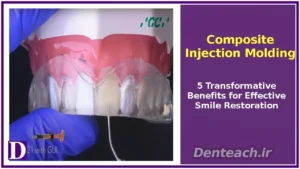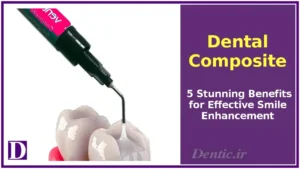
Table of Contents


Composite Injection Molding: 5 Transformative Benefits for Effective Smile Restoration

Dental Composite: 5 Stunning Benefits for Effective Smile Enhancement

Teeth Bleaching: 5 Radiant Benefits for Effective Smile Brightening

Dental Veneer: 5 Stunning Benefits for Effective Smile Enhancement

Implant-Supported Fixed Prostheses: 5 Advanced Benefits for Effective Smile Restoration

Composite injection molding, also known as composite bonding or flowable composite technique, is a groundbreaking advancement in cosmetic and restorative dentistry that redefines smile enhancement. This minimally invasive procedure utilizes flowable composite resin—a durable, tooth-colored material—applied through custom-designed templates to correct aesthetic imperfections such as chipped teeth, gaps, or minor misalignments. Unlike porcelain veneers, which require laboratory fabrication, composite injection molding is performed directly in the dental office, offering a rapid, cost-effective, and highly effective solution for smile restoration. With its ability to deliver natural-looking results while preserving tooth structure, this technique is transforming the field of cosmetic dentistry. This article explores the applications, detailed procedure, five transformative benefits, limitations, maintenance protocols, comparisons with other dental treatments, and practical guidance for patients considering this innovative solution.
What is Composite Injection Molding?
Composite injection molding is an advanced dental procedure where flowable composite resin is injected onto the teeth using precision-crafted templates to address aesthetic and minor functional issues. These issues include chipped, stained, or uneven teeth, as well as small to moderate gaps or misalignments. Performed chairside by a skilled dentist, this technique eliminates the need for laboratory processing, making it a quicker and more accessible alternative to porcelain veneers. The process leverages the flexibility of composite resin and the accuracy of digital or silicone templates to create a customized, natural-looking smile that enhances both aesthetics and patient confidence.
Applications of Composite Injection Molding
Composite injection molding is highly versatile, addressing a wide range of dental concerns in both cosmetic and restorative contexts:
- Tooth Reshaping: Enhances the appearance of short, small, or irregularly shaped teeth to achieve a balanced smile.
- Gap Closure: Eliminates small to moderate spaces between teeth for a seamless, uniform appearance.
- Repairing Damage: Restores chipped, cracked, or worn teeth caused by trauma, erosion, or grinding.
- Stain Concealment: Covers surface stains or mild discoloration resistant to traditional whitening treatments.
- Minor Alignment Correction: Straightens slightly crooked or uneven teeth without the need for orthodontic intervention.
Step-by-Step Procedure for Composite Injection Molding
The composite injection molding process is efficient, typically completed in one or two dental visits, depending on the number of teeth treated and the case’s complexity. The steps include:
- Initial Consultation and Smile Design
The dentist conducts a comprehensive evaluation of the patient’s oral health, examining teeth and gums to ensure suitability for the procedure. Digital scans, X-rays, or intraoral photographs are used to assess tooth structure and plan the treatment. Advanced digital smile design software or temporary mock-ups are employed to visualize the anticipated results and align with the patient’s aesthetic goals. - Template Fabrication
A custom silicone or digital template is created based on the patient’s dental impressions or 3D scans. This template ensures precise application of the composite resin, guaranteeing symmetry and consistency across the treated teeth. - Tooth Surface Preparation
Minimal or no enamel reduction is required, preserving the natural tooth structure. If necessary, less than 0.5 mm of enamel may be gently etched to enhance adhesion. The tooth surface is cleaned, dried, and treated with a bonding agent to ensure a secure bond with the composite resin. - Injection and Sculpting
Flowable composite resin is injected through the template onto the tooth surface. The dentist meticulously sculpts the material to achieve the desired shape, contour, and alignment, ensuring a natural and aesthetically pleasing result. A UV or LED curing light is applied in stages to harden the resin. - Polishing and Final Adjustments
Once hardened, the composite is polished to a smooth, glossy finish that mimics natural enamel. The dentist verifies the color, shape, and bite alignment, making minor adjustments to ensure a seamless integration with adjacent teeth.
Total Procedure Time: Typically 1–2 sessions, each lasting 1–2 hours, depending on the number of teeth and the complexity of the treatment.
5 Transformative Benefits of Composite Injection Molding
Composite injection molding offers a range of transformative advantages that make it a standout option in cosmetic and restorative dentistry:
- Minimally Invasive: Requires little to no enamel removal, preserving the integrity of natural teeth for long-term oral health.
- Rapid Results: Often completed in a single visit, delivering immediate smile transformations for time-conscious patients.
- Cost-Effective Solution: Significantly more affordable than porcelain veneers or other advanced cosmetic procedures, making it accessible to a wider range of patients.
- Highly Customizable: Allows precise color and shape matching to create a natural, harmonious smile tailored to the patient’s facial features.
- Easily Repairable: Damaged or stained composite can be quickly repaired or replaced without extensive procedures, offering flexibility and convenience.
Limitations of Composite Injection Molding
Despite its numerous advantages, composite injection molding has some limitations:
- Shorter Lifespan: Typically lasts 5–7 years, compared to 10–15 years for porcelain veneers, requiring periodic maintenance or replacement.
- Stain Susceptibility: Prone to discoloration over time from staining agents like coffee, tea, red wine, or smoking.
- Risk of Chipping: May fracture under excessive force, such as biting hard objects like ice or nuts.
- Skill-Dependent Outcomes: The quality of results relies heavily on the dentist’s expertise in sculpting and applying the composite resin.
- Not Suitable for Severe Cases: Ineffective for heavily damaged teeth, extensive decay, or significant orthodontic issues requiring comprehensive treatment.
Comparison with Porcelain Veneers
| Feature | Composite Injection Molding | Porcelain Veneers |
|---|---|---|
| Primary Goal | Aesthetic enhancement, minor corrections | Superior aesthetics, high durability |
| Tooth Reduction | Minimal or none | Slight (0.5–1 mm) |
| Lifespan | 5–7 years | 10–15 years |
| Cost | Low to moderate | High |
| Procedure Time | 1–2 sessions | 2–4 weeks |
| Stain Resistance | Moderate | High |
| Repairability | Easy | More complex |
Key Considerations:
- Speed and Affordability: Composite injection molding is faster and more budget-friendly but less durable than porcelain veneers.
- Aesthetics and Durability: Porcelain veneers offer superior stain resistance and a more polished, natural appearance.
- Invasiveness: Composite injection molding is less invasive, making it ideal for patients prioritizing tooth preservation.
Maintenance Tips for Composite Injection Molding
To ensure the longevity and aesthetics of composite restorations, patients should adhere to these essential care practices:
- Rigorous Oral Hygiene: Brush twice daily with a soft-bristled toothbrush, floss regularly, and use an antibacterial mouthwash to prevent decay or gum disease.
- Avoid Staining Substances: Limit consumption of coffee, tea, red wine, and other staining foods or drinks, especially for the first 24–48 hours post-treatment.
- Prevent Damage: Avoid chewing hard objects like ice, nuts, or using teeth to open packages to prevent chipping or fracturing the composite.
- Protect Against Bruxism: Use a custom-fitted nightguard for patients who clench or grind their teeth to safeguard the composite restorations.
- Regular Dental Checkups: Visit the dentist every 6 months for professional cleanings, polishing, and evaluation of the composite’s condition to maintain its appearance and functionality.
Suitable Candidates
Composite injection molding is ideal for individuals who:
- Have mild aesthetic issues such as stains, gaps, chips, or minor misalignment.
- Seek a rapid, cost-effective solution to enhance their smile without invasive procedures.
- Have healthy teeth and gums with no significant decay or periodontal disease.
- Are committed to maintaining proper oral hygiene and attending regular dental checkups.
Unsuitable Cases:
- Patients with severe tooth damage, extensive decay, or advanced gum disease requiring more comprehensive treatments.
- Individuals with habits like chewing hard objects or severe bruxism, unless protective measures like nightguards are implemented.
Frequently Asked Questions
Is composite injection molding painful?
No, the procedure is typically painless and rarely requires anesthesia, except in cases involving minor enamel etching for better adhesion.
How soon are results visible?
Results are immediate, as the procedure is often completed in one or two sessions, delivering an instant smile transformation.
Can composite injection molding be reversed?
Yes, the composite resin can be removed or replaced by a dentist with minimal impact on the natural tooth structure, making it a reversible option.
Conclusion
Composite injection molding is a transformative, minimally invasive solution for achieving an effective smile restoration by addressing aesthetic flaws like chips, gaps, or discoloration. Its affordability, speed, and ability to deliver natural-looking results make it an attractive option for patients seeking a quick and effective smile makeover. While it has limitations, such as a shorter lifespan and susceptibility to staining compared to porcelain veneers, its benefits outweigh the drawbacks for many. The success of this procedure depends on the dentist’s expertise and the patient’s commitment to proper maintenance. Consulting a qualified cosmetic dentist is essential to assess suitability and achieve a radiant, long-lasting smile that boosts confidence and enhances overall appearance.
